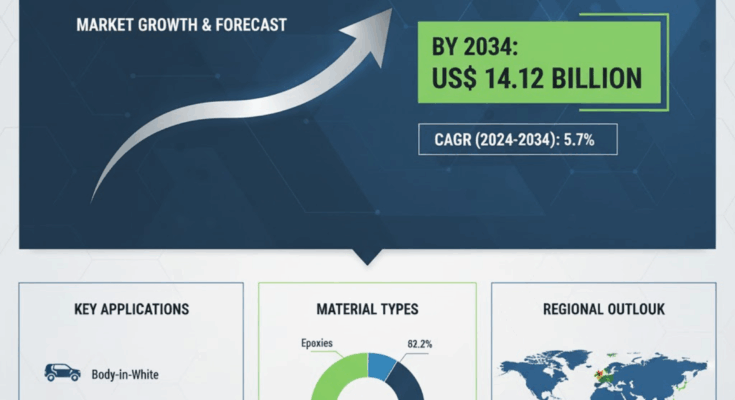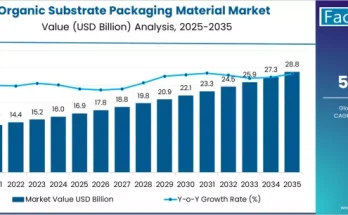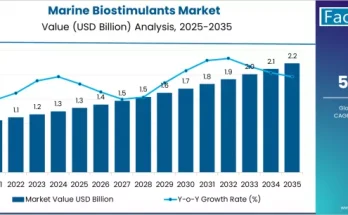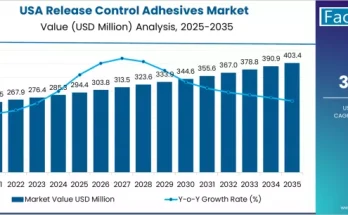The global automotive adhesives and sealants market is on track for significant expansion over the coming decade, driven by growing demand for lightweight vehicle architectures, stricter safety and environmental regulations, and the accelerating adoption of electric and autonomous vehicles. According to a recent study by Fact.MR, the market size is estimated at USD 8.11 billion in 2024, and is expected to nearly double to approximately USD 14.12 billion by 2034, growing at a compound annual growth rate (CAGR) of 5.7%.
Market Growth & Key Trends
The impetus for growth in the automotive adhesive and sealant market arises from the automotive industry’s parallel pushes for fuel efficiency, emissions reduction, and structural performance. Adhesives and sealants are increasingly preferred over traditional joining technologies such as welding or mechanical fasteners because they enable joining of dissimilar materials (metals, plastics, composites), contribute to weight reduction, and improve the overall durability of vehicles. This is especially important in high‐stress components, the body-in-white stage, and under-the-hood assemblies. Fact.MR specifically notes growing use of resin types such as polyurethane, epoxy, acrylic, PVA, EVA, and styrenic block resins, which can handle diverse substrates and operational demands.
Hot-melt adhesives, reactive adhesives, and advanced sealants that can survive temperature extremes, vibration, thermal cycling, and chemical exposure are becoming vital, especially in electric vehicles (EVs) and hybrids where performance demands are elevated. There is also increasing emphasis on noise, vibration, and harshness (NVH) control, vehicle aesthetics (e.g. seams, joints finishing), sealing against moisture and environmental exposure, and protection against corrosion.
Segment Dynamics & Regional Insights
By application, the body-in-white segment is forecast to be one of the fastest‐growing and highest‐value applications, both because of its structural demands and because it offers the greatest opportunity for weight savings. In 2024, body-in-white usage of adhesives & sealants is already strong, and Fact.MR projects it to reach approximately USD 4.63 billion by 2034 for that segment alone.
The assembly segment, including bonding, sealing, and fastening parts during the final build‐up of vehicle bodies, dashboards, seating components, interior trims, and other systems, also features prominently. It is expected to grow robustly as manufacturers seek better performance, faster production, improved safety and comfort (e.g. better sealing, quieter cabins).
Regionally, East Asia is a major market. In 2024, East Asia accounts for about 36.5% of the global market share, with China leading with a market value of around USD 1.68 billion in 2024 and forecast to grow at a CAGR of about 6.3% by 2034. The United States is another major market, holding almost USD 1.66 billion in 2024, with similar CAGR projections (~6.1%) through 2034. These regions are benefitting from large automotive manufacturing bases, increasing demand for EVs and lightweight vehicles, and improving regulatory environments around emissions, fuel economy, and safety.
Challenges & Restraints
While the market opportunity is strong, several headwinds remain. Raw material costs and supply stability are key risks; fluctuations in resin, polymer, and chemical additive prices can squeeze margins and raise production costs. Regulatory compliance is another challenge: adhesives and sealants must satisfy stringent environmental, chemical safety, emissions (VOC), thermal stability, durability, crash safety, and sometimes end-of-life recyclability standards, depending on the region.
Another constraint is the competition from traditional joining methods and cost pressures in lower-priced vehicle segments that may be less willing to absorb premium adhesive/sealant costs. Also, deployment of advanced adhesives requires investment in engineering design, testing, qualification, and sometimes new manufacturing equipment or process changes.
Competitive Landscape & Major Players
The global automotive adhesive and sealant industry is fairly well populated with major chemical, materials, and specialty matter companies that have deep R&D, wide product portfolios, and global distribution. Among the leading players cited in the Fact.MR analysis are BASF SE, Jowat SE, H.B. Fuller Company, Illinois Tool Works, Inc., 3M, TESA SE, Avery Dennison Corp., Arkema Group, Huntsman International, Delo, Bostik, Henkel AG & Co. KGaA, The Dow Chemical Company, Sika AG, Solvay S.A., PPG Industries, Inc., Evonik Industries AG, ITW Performance Polymers, Akzo Nobel N.V., and others. These players are investing in product innovation (for stronger, more durable adhesives and sealants), sustainability (lower VOCs, greener chemistries), and capacity expansions in key regions like East Asia and North America.
Recent strategic moves include new product launches targeting EV applications, seals and adhesives designed for higher thermal stability and vibration resilience, and portfolio expansion through acquisitions or cooperative R&D.
Forecast and Market Outlook
At the projected CAGR of 5.7%, the market is expected to reach USD 14.12 billion by the end of 2034. This projected growth reflects not only volume gains tied to increasing vehicle production globally, but also a shift toward higher‐value adhesives and sealants with more demanding performance specifications.
Emerging opportunities are especially strong in EVs, where bonding and sealing needs for batteries, thermal management, lighter frames and integrated composite structures demand advanced materials. Also, as environmental regulations tighten across jurisdictions (emissions, recyclability, VOCs, safety), compliance-oriented adhesive technologies will gain more importance.
Lower‐cost vehicle segments and developing markets might lag in high-performance adoption initially, but as economies grow and regulatory/consumer pressures increase, demand from these markets is expected to rise steadily. There is also likely to be increasing consolidation, partnerships, and vertical integration (from resin/chemical feedstock providers to application engineering) among leading suppliers to secure raw materials, ensure consistent quality, and improve R&D speed.
Implications for Stakeholders
Automotive OEMs (Original Equipment Manufacturers), adhesives & sealants suppliers, material chemists, and regulators all have roles to play in the unfolding market. OEMs will need to incorporate adhesive-friendly designs early in vehicle architecture; suppliers must innovate not only in product performance but also in sustainability and cost economics; regulators are expected to refine rules around chemical safety, emissions (VOCs), durability, recyclability; and investors should watch expansion opportunities especially in Asia Pacific and East Asia, EV-focused product lines, and new extraction/resin chemistries.
Browse Full Report : https://www.factmr.com/report/automotive-adhesive-and-sealant-market



